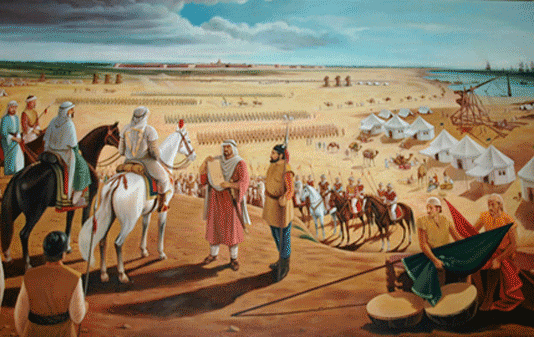How Islam Flourished In Sindh? Part-II


Due to pre-existing ties between the area and the Sassanian Empire, the history of military encounters between people from modern-day Pakistan and the Islamic world precedes the Indus Valley’s actual incorporation into the Islamic caliphates.
Since Herodotus (484–485 BCE) reports that fighters from the Satrapies in the Indus basin were present at the battles of Thermopylae and Marathon, it is clear that the Persian tradition of enlisting foot soldiers, archers, and cavalry from the Indus Valley dates back to the Achaemenid era.
The Sassanians also used a similar style of recruitment, with emperors like Bahram V settling huge numbers of members of the Jatt nomadic community from the Indus Valley.
The Sassanid army used the soldiers among them as soldiers, and they also protected Persia’s routes, means of trade, and transportation. They were mainly located in the southwest of the country.
These organisations were some of the first to combat the Muslim armies on behalf of the Sassanians, and they were tasked with defending important Sassanid cities like Ahvaz in addition to serving as auxiliary forces in the Sassanid armies for further support.
These Jatts, known as Zutt in Arabic, were among the first in Persia to accept Islam and so engage with the Muslim forces in their further conquests after the Sassanid Empire suffered heavy defeats at the hands of the Rashidun Caliphate.
When the Ummayad Caliphate conquered the Indus Valley in 711 CE, they were later resupplied with more of their warriors.
Since they were used by Caliph Ali (601-661 CE) to protect the city of Basrah and the royal coffers during one of the most crucial and politically significant conflicts in Islamic history, the Battle of the Camel, it is clear that jatts enjoyed a position of significance in the early Islamic period (656 CE).
Byzantine historians would mention these Jatts as possibly the ‘Indians’ who were a part of Thomas the Slav’s armies during his uprising (821–823 CE) against the Byzantine empire, possibly as a group of skilled warriors sent by the Abbasid Caliph to Thomas as assistance. This is according to Spanish author Juan Signes Codoner.
The Chronicles of Zuqnin, a collection of Syriac manuscripts from the eighth century, also specifically mentions Sindh because its warriors participated in the massive army that attacked the Byzantine province of Edessa in 767 CE.
The fact that these soldiers existed as Mamluks (slave soldiers) is extremely important because it happened roughly two centuries before the Ghaznavids established the right idea of Mamluk warriors in the Indus Valley.
Al-Sindhi Ibn Bukhtashah, a warrior who led the right flanks of the general Wasif al-Turki in one of the earliest Muslim incursions into Anatolia in 862 CE, is mentioned by the historian Al-Tabbari (839-923 CE) in his 33rd volume. The warrior’s native country is not exactly known, though.
The Abbasid caliphate’s influence in the Indus Valley started to decline as the ninth century progressed, while the influence of the Arab tribes that had migrated there started to grow. Due to this, the Indus Valley saw a complex political situation in the later half of the 9th century, with quasi-independence and nominally lax dependence on the Abbasids.
Near the turn of the century, as a result of this scenario, the Abbasid Empire in the Indus Valley completely collapsed, splitting into two states: the Emirate of Multan in the north, ruled by the Banu Samahs, and the Emirate of Mansura in the south, ruled by the Habbarids.
Ismaili preachers were able to amass significant authority as a result of the rise of smaller, weaker governments, and they finally succeeded in assuming control of the Emirate of Multan and extending their dominance in the region. This development changed the Indus Valley’s connection from the Tigris and the Gulf to the Nile and the Red Sea, replacing the prominence once held by the Abbasid kings of Baghdad with the growing relevance of the Fatimid rulers of Egypt.
Indus Valley and its immediate western neighbours were unable to maintain a significant amount of religious and intellectual communication, which inevitably waned over time as a result of such unstable political environments.
Later, in the 11th century, the rise of Turco-Mongol warlords from Central Asia reconnected the Indus Valley with the west and ushered in a new era of scholarly exchange, beginning a new tradition of intellectual and theological contact between South Asia and the Muslim world that persisted for more than half of the previous millennium.
Source: https://www.dawn.com/news/1731742/how-the-indus-valley-fed-islams-golden-age
DISCLAIMER: The author is solely responsible for the views expressed in this article. The author carries the responsibility for citing and/or licensing of images utilized within the text.
